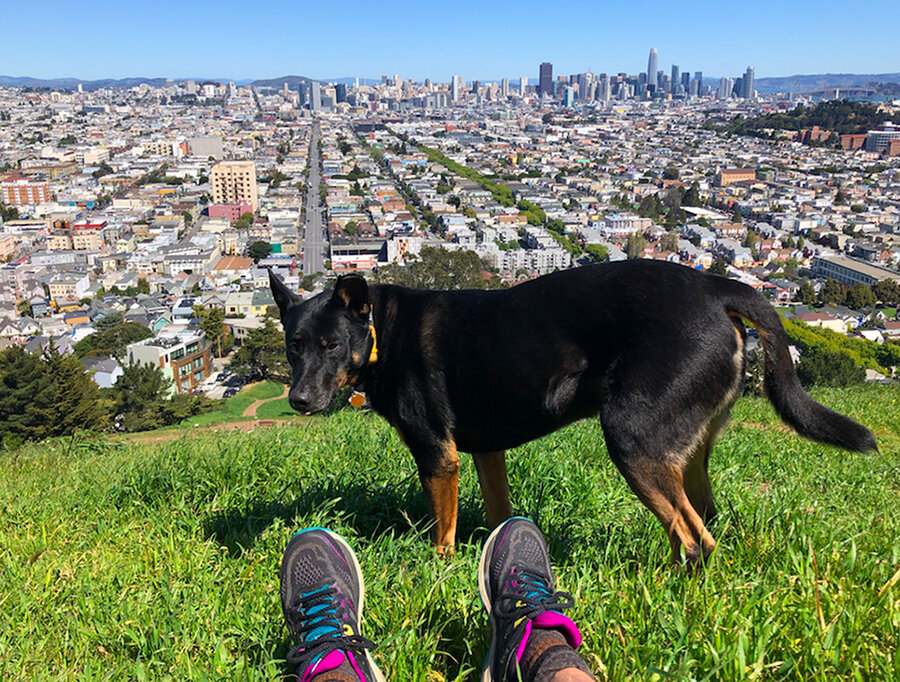Stepping Out: How to Run With Your Dog

I’ve been a runner for 20 years now. Sometimes I get serious about it and train for a particular race, but mostly I’m a casual runner. I’m lucky that all my dogs have enjoyed running with me because I don’t like running without a dog.
When my dogs get old and can no longer run, I usually take a break from running. But with each new puppy, I anxiously wait for them to reach maturity so I can start running again. With our year-round temperate weather, views in every direction, and plenty of trails, dog-friendly San Francisco is a runner’s paradise. And nothing’s better than getting out there with a furry pal beside you.
It’s important to remember that not all dogs are suited for running. Brachycephalic breeds, which are dogs with short snouts, definitely should not run. This includes French Bulldogs, Pugs, Boxers, Bulldogs, Shih Tzus, Pekingese, or any other short-snout breeds or mixes. So if you’ve got a snub-nosed pup at your house, look around for another activity.
If you and your dog aren’t regular runners, you may need some basic training before you’re both ready to lace up and leash up. Here’s what you need to know to get started.
Don’t start running with your dog until their muscles and bones are fully formed. For medium to large breed dogs, wait until they are 18 months old. Small breeds like Beagles, Papillons, Jack Russells, and other terriers make great running companions and can start running when they are 12 months old. Always talk with your vet before beginning any new exercise regimen with your dog.
Dogs age faster than humans so be prepared for your older dog to retire from running sooner than you might expect. My Chihuahua/Jack Russell was an enthusiastic running buddy for over a decade, but now in her arthritic senior years, she’s become the quintessential couch and lap dog. You wouldn’t make your grandmother run a marathon. Show your senior dog the same respect.
Just like people, not all dogs enjoy running. Your dog might be the sniff and meander type or prefer fetch to a 5K. Some fit and athletic dogs are eager runners for a mile or two but get bored with longer runs. Forcing them to do an activity they don’t enjoy isn’t fair or humane.
If your dog typically loves running and then suddenly becomes reluctant to join you, see your vet to rule out any physical problems. But even if your dog can’t or doesn’t want to run, you aren’t doomed to running alone. Consider volunteering at a local shelter or rescue. There are plenty of cage-bound dogs who would love an opportunity to stretch their legs.
Before taking your dog on a run, take the time to teach loose-leash walking. Dogs who pull or criss cross in front of you when walking on a leash will make running together frustrating. Unfortunately, there is no quick fix or magical piece of equipment for dogs who pull. You’ll need to take the time to teach leash manners using a front-clip harness, plenty of treats, and a pile of patience. This video will get you started with correct leash training. But if you’re still struggling with pulling on walks, you may consider hiring a force-free dog trainer.
Begin slowly to allow your dog to build up endurance for your runs together. Use the 10-percent rule and do not increase your dog’s weekly mileage by more than 10 percent over the previous week.
Let your pup set the pace. Dogs can’t tell you when they need a break, so stop frequently and check-in with your pup. Are they lying down when you stop or still raring to go? If your dog starts lagging or panting heavily, switch to walking. Some dogs won’t stop until you do, even if they are tired or ready to quit, so don’t overdo it. Remember that your dog will need rest days, just as you do.
Fortunately, your dog won’t need expensive running shoes every six months. But there are a few essentials that will help simplify your runs together.
A harness with a D-ring on the back is a must-have. The leash won’t get tangled in the dog’s legs, and harnesses prevent damage to your dog’s neck and trachea. Hands-free leashes that clip around your waist are also essential. I’ve tried pricey hands-free leash systems but found they don’t work any better than a basic $15 hands-free leash.
Carrying some gear is necessary when your dog is with you. I’ve found Nathan Hydration Packs (made for ultra-runners and trail runners) will hold poop bags, a collapsible water bowl, and a water bladder. The front pockets are perfect for treats and a cell phone.
Dogs can’t sweat so always carry water and a collapsible bowl. If the temperature is over 75 degrees, skip the run. Black or dark-colored dogs in the sun will overheat faster, as will double-coated dogs. Also remember that hot asphalt can burn your dog’s paw pads. When the ambient air is 77 degrees, the pavement can be as hot as 125 degrees in the sun.
I love a good burrito after a long run, and your dog deserves some yummy calories, too. Give your dog extra food on run days, or treat them to a special meal after a work-out.
If your dog has excellent recall and will run with you without being tethered, go on an adventure by running some of the many off-leash trails in the Bay Area. Looking for company on the trail? Check your local Canicross chapter to find canine and human running pals.
Running with your dog in the fresh spring air is a joy like no other. Just remember to take care of that sporty pup and you’ll have miles of fun out there together!

